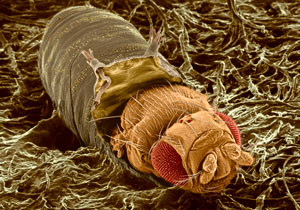 An adult fruit fly emerging from a pupa. A RIKEN researcher has investigated the role steroid signaling plays in glucose metabolism during the transition to the pupal stage.© DR JEREMY BURGESS/SCIENCE PHOTO LIBRARY
An adult fruit fly emerging from a pupa. A RIKEN researcher has investigated the role steroid signaling plays in glucose metabolism during the transition to the pupal stage.© DR JEREMY BURGESS/SCIENCE PHOTO LIBRARY
A biologist at RIKEN has discovered the way in which steroid signaling regulates the breakdown of sugar molecules in fruit flies so as to provide the energy larvae need to enter the pupal stage1. This finding could have much wider implications that may extend to life-stage changes in people.
Steroid hormones regulate many developmental transitions in animals, from metamorphosis in insects to puberty in people. Yet the compounds that determine the energy metabolism in these biological events have long been overlooked.
"Considerable changes in metabolism and body composition also occur in humans, first during embryonic development and then on through adolescence," notes Takashi Nishimura of the RIKEN Center for Biosystems Dynamics Research. "Hence, my work linking steroids and nutrients in flies may contribute to a deeper understanding of metabolic changes specific to life stages in general."
In his present study, Nishimura focused on the 12-hour window after fruit-fly larvae first build a hardened exoskeleton around their maggoty bodies and enter the pupal stage, during which the adult body forms. This process kicks off with a pulse of steroid production. Nishimura showed that the steroid then interacts with a hormone receptor to activate an enzyme involved in converting a sugar found in the blood-like hemolymph of flies into glucose-an essential energy source needed to make the building blocks and cellular materials as larvae transform into adults.
 Takashi Nishimura has found that temporal coordination of hormonal signaling and nutrient metabolism drives a critical life-cycle transition in fruit flies.© 2020 RIKEN
Takashi Nishimura has found that temporal coordination of hormonal signaling and nutrient metabolism drives a critical life-cycle transition in fruit flies.© 2020 RIKEN
The additional glucose not only fuels these developmental changes; it also spurs the synthesis of more steroid hormone, a cue needed to complete the transition to a pupa.
The findings thus reveal the tight connection between metabolism and hormonal signaling in a manner that is highly regulated across temporal scales. They also highlight how nutrient metabolism is mechanistically linked to cellular and developmental programs through both its bioenergetic and messenger functions.
"This developmental transition is elegantly coupled with nutrient metabolism through the action of steroid hormone, a biological system that provides cellular energy and materials when needed," Nishimura explains.
Nishimura's demonstration of the complex and interconnected functions of metabolism and hormones in the developing fruit fly, a laboratory model, could also help to account for diseased states, such as cancer, that occur when the delicate balance of these processes goes awry. "Metamorphosis is specific to insects," Nishimura notes, "But steroid-driven relevant phenomena in mammals are common, both for health and disease." His findings could thus have far-reaching consequences for biology broadly, including our own.






